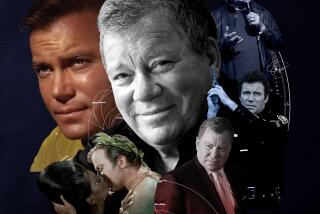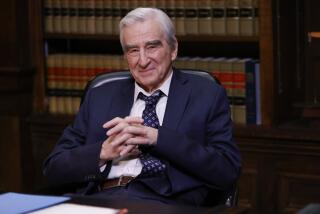Murder, He Presented
- Share via
Though he had been scaring the wits out of moviegoers for nearly 30 years, Alfred Hitchcock, in his words, “brought murder back into the living room--where it belongs.” He was host, executive producer and occasional director of the 1955-65 anthology series “Alfred Hitchcock Presents,” which aired on CBS and then moved to NBC (in its last three years expanded to an hour, retitled “The Alfred Hitchcock Hour”).
On Friday, the Museum of Television & Radio begins “Murder in the Living Room: Hitchcock by Hitchcock,” a three-month series exploring Hitchcock’s themes and techniques that would later turn up in some of his greatest films, including “Vertigo” and “Psycho.”
Though Hitchcock was an acclaimed director, the series made him a TV star thanks to his wry, witty performance as host. Appearing in silhouette to the strains of Gounod’s “Funeral March of a Marionette,” Hitchcock would comment on the episode and offer up a barb or two about the sponsor. At the episode’s conclusion, he’d return to tie up loose ends.
Norman Lloyd, best known as kindly Dr. Auschlander on the series “St. Elsewhere,” worked on the Hitchcock series for the last eight seasons, first as an associate producer and eventually as executive producer. He also directed numerous episodes, including the famous “Man From the South” with Peter Lorre and Steve McQueen and one of Hitchcock’s favorites, “The Jar.”
Lloyd first worked with Hitch in 1942’s “Saboteur” and later in 1945’s “Spellbound.” Now 82, he spoke recently about his great friend and colleague, who died in 1980 at 80.
*
Question: Is it true that Hitchcock preferred not to use original scripts on the series?
*
Answer: He found that for his particular kind of story, known as the “Hitchcock story,” the show was better off with a story already written as a short story, because it had a beginning, middle and end. The end was very important in the case of a Hitchcock show because it dealt with what was called the “twist.” Every show had to have a twist. We never could trust an original [story] to have a twist. If you fooled around with an original, you might find yourself in deep water and not able to get back to shore.
Q: It was unusual for such a successful and popular film director to do television in the 1950s.
A: [Television] was sort of looked down upon. This was the remarkable thing about him agreeing to do television. He was asked to do it by [his agents]. They saw the great commercial value of having sponsors buy the show. So when Hitch agreed, he became a flagship. They could go to many stars and say, “Look, we have Hitchcock.” Stars agreed to do it because of Hitchcock’s name.
At that time it was a daring thing for him to do. It was one of his most fertile periods, if you check the pictures he was making, like “Rear Window,” “Vertigo’ and “Psycho.” The whole thing added up to an enormous plus.
“Psycho,” by the way, he made as a television film, not for television but using a TV crew and showing that it could be done--that is physically--as a television show.
Q: Were the clever wraparounds Hitchcock’s idea?
A: I can’t answer that because I don’t know, but I will tell you that [they worked because of] a genius in addition to Hitch, Jimmy Allardice, who wrote every one of those for 10 years.
These lead-ins were absolutely marvelous. There has been nothing before or after on TV. Jimmy found his voice through Hitchcock. Hitchcock would do anything that Jimmy wrote. I mean, I would read these lead-ins when they would come in and I would say: “Impossible. Hitch will never do this. He won’t get out there in knickers and a golf club.” He did them. He got inside a bottle. They got a real lion and Hitch worked with a lion. Hitch played his own brother, Albert Hitchcock. All of these were inventions of Jimmy. Hitchcock, with his shrewd showmanship and instinct, never questioned one of them. He did every single one of them.
Q: Though Hitchcock was a star before the series, I am sure coming into everyone’s homes on a weekly basis turned him into a superstar.
A: He was an internationally famous motion picture director, but known to a limited few or those who saw those features. But with the TV show, he became an international superstar with these lead-ins. He became a major, major star personality with that show.
Hitch directed the most famous of [all the episodes] called “Lamb to the Slaughter.” That is a classic. He directed several marvelous ones [including] “Dip in the Pool.” They ought to send every kid director from the AFI [American Film Institute] or the film school down at USC to see these, to see how to tell a story. [Both screen Aug. 14-24.]
Q: Did you and Hitchcock work together after the series ended?
A: Not on television. That was the end of all television for Hitch. One reason it ended after 10 years was that he said he had it. He didn’t want to do it anymore.
At the end of his life, he had a property called “Short Night” and tried several runs at that book to get a screenplay that he was satisfied with out of it. I worked with him during that period, but it never came to anything. He was in his 80s and physically suffering from terrible arthritis and a bad heart, so he wasn’t going to push it. One day he said to me while we were working: “Norm, we’re not going to make this picture?” I said, “Why do you say you’re not going to make it?” He said, “Because it’s not necessary.” I think that is such a great line. After making 52 pictures, you can say that.
(BEGIN TEXT OF INFOBOX / INFOGRAPHIC)
These ‘Murders’ Are on Schedule “Murder in the Living Room: Hitchcock by Hitchcock” runs Friday through Sept. 28. Screenings are Thursdays at 5 and 7 p.m., Fridays at 3 p.m. and Saturdays and Sundays at 1 and 3 p.m.
Here is the schedule, with program themes and episodes listed. (Episodes directed by Hitchcock unless otherwise noted.)
Friday through June 29: Unveiling Vera Miles: “Pepsi-Cola Playhouse: The House Where Time Stopped,” directed by Herschel Daugherty, “Alfred Hitchcock Presents: Revenge,” “Alfred Hitchcock Presents: Incident at a Corner.”
July 3 through 13: Cases of Misplaced Identity: “Alfred Hitchcock Presents: Breakdown,” “Alfred Hitchcock Presents: The Case of Mr. Pelham,” “Alfred Hitchcock Presents: Poison.”
July 17 through 27: Corpse Disposal: “Alfred Hitchcock Presents: Back for Christmas,” “Alfred Hitchcock Presents: Mr. Blanchard’s Secret,” “Alfred Hitchcock Presents: The Perfect Crime.”
July 31 through Aug. 10: The Guilt Trade: “Alfred Hitchcock Presents: Wet Saturday,” “Alfred Hitchcock Presents: The Horseplayer,” “The Alfred Hitchcock Hour: I Saw the Whole Thing.”
Aug. 14 through 24: The Roald Dahl Collection: “Alfred Hitchcock Presents: Lamb to the Slaughter,” “Alfred Hitchcock Presents: Dip in the Pool,” “Alfred Hitchcock Presents: Mrs. Bixby and the Colonel’s Coat.”
Aug. 28 through Sept. 7: The Ticking Clock: “Suspicion: Four O’Clock,” “Alfred Hitchcock Presents: Bang! You’re Dead,” “Alfred Hitchcock Presents: The Crystal Trench.”
Sept. 11 through 21: Anticipating Psycho: “Alfred Hitchcock Presents: One More Mile to Go,” “Alfred Hitchcock Presents: Banquo’s Chair,” “Alfred Hitchcock Presents: Arthur.”
Sept. 25 through 28: Hidden Hitchcock: “Ship’s Reporter” with Hitchcock, hosted by Jack Mangan; “Tactic” with Hitchcock and William Shatner; “Alcoa Premiere: The Tactic,” directed by Norman Lloyd.
BE THERE
The Museum of Television & Radio, 465 N. Beverly Drive. Admission is $6 for adults; $4 for students and senior citizens and $3 for children. Member are admitted free. Information: (310) 786-1025.
More to Read
The complete guide to home viewing
Get Screen Gab for everything about the TV shows and streaming movies everyone’s talking about.
You may occasionally receive promotional content from the Los Angeles Times.







